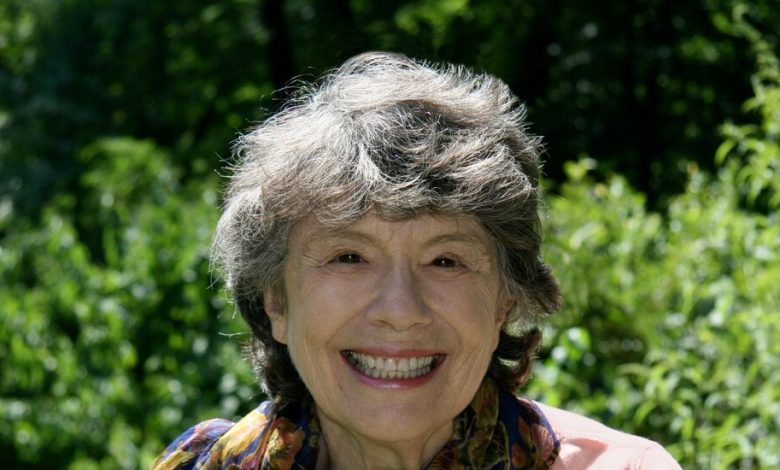Mary Ann Hoberman, Who Tantalized Young Readers With Rhymes, Dies at 92

Mary Ann Hoberman, whose dozens of rhyme-filled books for children sought to encourage them to read — especially to read aloud — and to commit poems to memory, died on July 7 at her home in Greenwich, Conn. She was 92.
Little, Brown Books for Young Readers, which published many of her books, announced her death, from a long illness that was not specified.
Ms. Hoberman wrote poems about animals (“The Llama Who Had No Pajama” was one of her classics), clothes, friendship, families, finicky eaters and assorted other subjects of interest to youngsters.
“She had a gift for finding the extraordinary in everyday things — buttons and pennies, butter and jam,” Megan Tingley, president of Little, Brown Books for Young Readers, who had worked with her for more than 35 years, said in a statement. “She could write a poem about anything.”
Ms. Hoberman started her career with feet. She had always enjoyed writing light verse, and in her mid-20s she sent some off to a publisher; the result was “All My Shoes Come in Twos,” poems about different kinds of shoes. Published in 1957, it was illustrated by her husband, Norman Hoberman, an architect.
“Easy to read and fun to listen to read aloud,” The Fresno Bee of California wrote, “it will appeal to small clothes-conscious ladies.”
Three other books, also illustrated by her husband, followed in the next five years, and her career took off, ultimately encompassing more than 50 books, with another due next year.
Perhaps her most acclaimed book was “A House Is a House for Me” (1978, illustrated by Betty Fraser), which won a National Book Award. Its verses touched on homes of various kinds, both for living creatures and for other things.
Barrels are houses for pickles
And bottles are houses for jam.
A pot is a spot for potatoes.
A sandwich is home for some ham.
It ended with a leap from the micro to the macro:
A flower’s at home in a garden.
A donkey’s at home in a stall.
Each creature that’s known has a house of its own
And the earth is a house for us all.
One of the admiring critics, Harold C.K. Rice, wrote in The New York Times Book Review: “With surreal precision and changes of scale and color, animals — big and small, wild and tame — are placed cheek by jowl with children and familiar objects, and all are gathered together with a kind of demented enthusiasm; the book is a manic cornucopia of images and ideas.”
In addition to books she wrote herself, Ms. Hoberman compiled poetry collections aimed at young readers, including “Forget-Me-Nots: Poems to Learn by Heart” (2012, illustrated by Michael Emberley), which gathered pieces from a wide range of poets, including Gwendolyn Brooks, Carl Sandburg, Emily Dickinson and Elizabeth Coatsworth. It began with one of her own, “A Poem for the Reader,” encouraging children to make the poems their own:
You’ll pick out your favorites
From those that you’ve read
And invite them to live in
The house in your head.
This house is called Memory,
Everyone knows,
And the more you put in it,
The larger it grows.
In 2008, when the Poetry Foundation named her “Children’s Poet Laureate,” a title that she held until 2011 and that made her a sort of poetry ambassador to young readers, Ms. Hoberman told The Chicago Tribune how she envisioned poetry’s role.
“I don’t like it when a four-line poem of mine is in a teacher’s manual, and there are three pages on how to use it across the curriculum, and it’s analyzed to death,” she said. “That’s not what poetry is for. It’s for joy.”
Mary Ann Freedman was born on Aug. 12, 1930, in Stamford, Conn., and grew up there. Her father, Milton, was a salesman and later a businessman, and her mother, Dora (Miller) Freedman, was a homemaker.
“I think I was about 4 years old when I first understood that many of the stories I loved so much had been made up by real people, with real names, rather than having always been here like the moon or the sky,” Ms. Hoberman said in an interview recounted on her website. “I decided then that when I grew up I would write stories, too, that would be printed in books for other people to read.”
In a 2008 interview with the Poetry Foundation, she said that moments from her childhood were reflected in her books.
“I started writing when I had children of my own,” she said “but I wasn’t really observing them so much as remembering what it was to be a child myself.”
She earned a bachelor’s degree at Smith College in 1951 and, some 35 years later, a master’s degree in English literature from Yale. She and Mr. Hoberman married in 1951.
Among her best-known other books was “The Seven Silly Eaters” (1997, illustrated by Marla Frazee), about a mother’s struggles to accommodate her children, each of whom will eat only a particular food.
“Hoberman’s riotous tale is spun like a Seussian fable,” Jon Agee wrote in The Times Book Review, “and told, as the Doctor would have told it, in an up-tempo, whimsical rhyme.”
Ms. Hoberman also wrote a series of books under the rubric “You Read to Me, I’ll Read to You” that were intended to be read aloud by two people, alternating lines or sometimes reading them in unison.
“Each short, rhymed story in this book is like a little play for two voices,” she wrote in an author’s note in one of them, “Very Short Stories to Read Together” (2001). The idea was to encourage not just reading, but reading aloud.
“I think that my poems begin in my feet,” Ms. Hoberman once said. “Nothing gets me started on a poem like a walk. In some uncanny way, the steady rhythm of my step allows new ideas to surface and take hold in my mind. Sometimes the beat comes with words attached. Sometimes it is only a wordless cadence that must find its language. But once it manifests itself, I know that sooner or later, the poem will follow.”
Ms. Hoberman’s husband died in 2015. She is survived by four children, Diane Louie and Perry, Chuck and Meg Hoberman; and six grandchildren.
In its announcement of her death, Ms. Hoberman’s publisher said she had written a poem for her own farewell party, which was held days before she died. It ended with these lines:
As mother, sister, friend and wife,
I’ve had a super duper life
You’re the ones who made it so
And now it’s time for me to go.
My time has come. The water’s wide.
I’ll see you on the other side.



